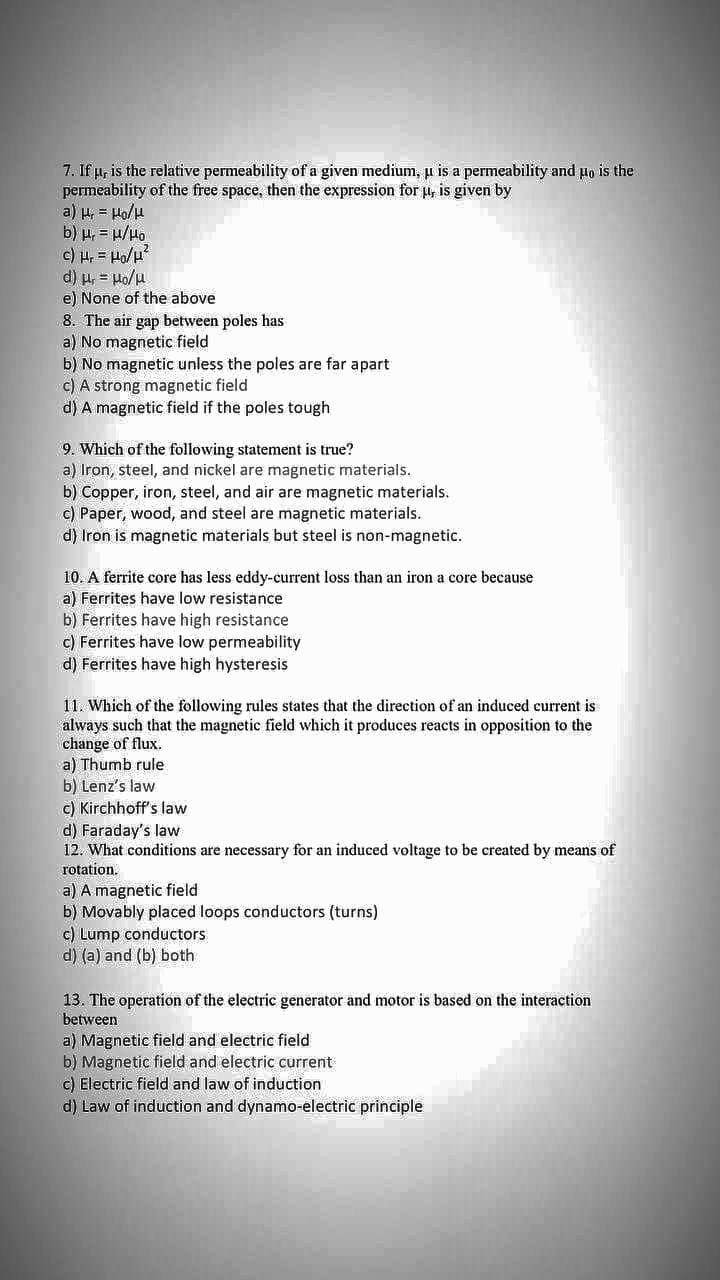7. If p, is the relative permeability of a given medium, u is a permeability and po is the permeability of the free space, then the expression for u, is given by a) u, = Ha/u b) H, = H/Ho c) Hi = Ho/ !! e) None of the above 8. The air gap between poles has a) No magnetic field b) No magnetic unless the poles are far apart c) A strong magnetic field d) A magnetic field if the poles tough 9. Which of the following statement is true? a) Iron, steel, and nickel are magnetic materials. b) Copper, iron, steel, and air are magnetic materials. e) Paper, wood, and steel are magnetic materials. d) Iron is magnetic materials but steel is non-magnetic. 10. A ferrite core has less eddy-current loss than an iron a core because
7. If p, is the relative permeability of a given medium, u is a permeability and po is the permeability of the free space, then the expression for u, is given by a) u, = Ha/u b) H, = H/Ho c) Hi = Ho/ !! e) None of the above 8. The air gap between poles has a) No magnetic field b) No magnetic unless the poles are far apart c) A strong magnetic field d) A magnetic field if the poles tough 9. Which of the following statement is true? a) Iron, steel, and nickel are magnetic materials. b) Copper, iron, steel, and air are magnetic materials. e) Paper, wood, and steel are magnetic materials. d) Iron is magnetic materials but steel is non-magnetic. 10. A ferrite core has less eddy-current loss than an iron a core because
Introductory Circuit Analysis (13th Edition)
13th Edition
ISBN:9780133923605
Author:Robert L. Boylestad
Publisher:Robert L. Boylestad
Chapter1: Introduction
Section: Chapter Questions
Problem 1P: Visit your local library (at school or home) and describe the extent to which it provides literature...
Related questions
Question
I need the answer as soon as possible

Transcribed Image Text:7. If µr is the relative permeability of a given medium, u is a permeability and Ho is the
permeability of the free space, then the expression for Hr is given by
1/eM = (e
b) µ, = H/Ho
c) H, = Ho/u*
1/eri = 'n (p
e) None of the above
8. The air gap between poles has
a) No magnetic field
b) No magnetic unless the poles are far apart
c) A strong magnetic field
d) A magnetic field if the poles tough
9. Which of the following statement is true?
a) Iron, steel, and nickel are magnetic materials.
b) Copper, iron, steel, and air are magnetic materials.
e) Paper, wood, and steel are magnetic materials.
d) Iron is magnetic materials but steel is non-magnetic.
10. A ferrite core has less eddy-current loss than an iron a core because
a) Ferrites have low resistance
b) Ferrites have high resistance
c) Ferrites have low permeability
d) Ferrites have high hysteresis
11. Which of the following rules states that the direction of an induced current is
always such that the magnetic field which it produces reacts in opposition to the
change of flux.
a) Thumb rule
b) Lenz's law
c) Kirchhoff's law
d) Faraday's law
12. What conditions are necessary for an induced voltage to be created by means of
rotation.
a) A magnetic field
b) Movably placed loops conductors (turns)
c) Lump conductors
d) (a) and (b) both
13. The operation of the electric generator and motor is based on the interaction
between
a) Magnetic field and electric field
b) Magnetic field and electric current
C) Electric field and law of induction
d) Law of induction and dynamo-electric principle
Expert Solution
This question has been solved!
Explore an expertly crafted, step-by-step solution for a thorough understanding of key concepts.
Step by step
Solved in 2 steps with 1 images

Knowledge Booster
Learn more about
Need a deep-dive on the concept behind this application? Look no further. Learn more about this topic, electrical-engineering and related others by exploring similar questions and additional content below.Recommended textbooks for you

Introductory Circuit Analysis (13th Edition)
Electrical Engineering
ISBN:
9780133923605
Author:
Robert L. Boylestad
Publisher:
PEARSON

Delmar's Standard Textbook Of Electricity
Electrical Engineering
ISBN:
9781337900348
Author:
Stephen L. Herman
Publisher:
Cengage Learning

Programmable Logic Controllers
Electrical Engineering
ISBN:
9780073373843
Author:
Frank D. Petruzella
Publisher:
McGraw-Hill Education

Introductory Circuit Analysis (13th Edition)
Electrical Engineering
ISBN:
9780133923605
Author:
Robert L. Boylestad
Publisher:
PEARSON

Delmar's Standard Textbook Of Electricity
Electrical Engineering
ISBN:
9781337900348
Author:
Stephen L. Herman
Publisher:
Cengage Learning

Programmable Logic Controllers
Electrical Engineering
ISBN:
9780073373843
Author:
Frank D. Petruzella
Publisher:
McGraw-Hill Education

Fundamentals of Electric Circuits
Electrical Engineering
ISBN:
9780078028229
Author:
Charles K Alexander, Matthew Sadiku
Publisher:
McGraw-Hill Education

Electric Circuits. (11th Edition)
Electrical Engineering
ISBN:
9780134746968
Author:
James W. Nilsson, Susan Riedel
Publisher:
PEARSON

Engineering Electromagnetics
Electrical Engineering
ISBN:
9780078028151
Author:
Hayt, William H. (william Hart), Jr, BUCK, John A.
Publisher:
Mcgraw-hill Education,